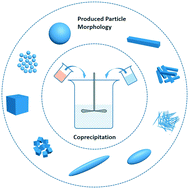A review on synthesis and engineering of crystal precursors produced via coprecipitation for multicomponent lithium-ion battery cathode materials
Abstract
Interest in developing high performance lithium-ion rechargeable batteries has motivated research in precise control over the composition, phase, and morphology during materials synthesis of battery active material particles for decades. Coprecipitation, as one of the most reported methods in the literature to produce precursors for lithium-ion battery active materials, has drawn attention due to its simplicity, scalability, homogeneous mixing at the atomic scale, and tunability over particle morphology. This highlight summarizes the advancements that have been made in producing crystalline particles of tunable and complex morphologies via coprecipitation for use as lithium-ion battery precursor materials. Comparison among different crystallization reagents, solution conditions that influence the properties of crystal particles, and the fundamental knowledge from equilibrium and/or kinetic study of the coprecipitation processes, are systematically discussed. The research reports and guiding principles summarized in this highlight are meant to improve selections made by researchers to efficiently determine synthesis conditions. In addition, it is desired that the methods applied from the study of crystallization will inspire researchers to pursue further investigation of the nucleation and growth mechanisms of these coprecipitation processes, which will be necessary to achieve truly predictive particle synthesis.

- This article is part of the themed collections: Crystal engineering for electrochemical applications and 2019 Highlight article collection


 Please wait while we load your content...
Please wait while we load your content...